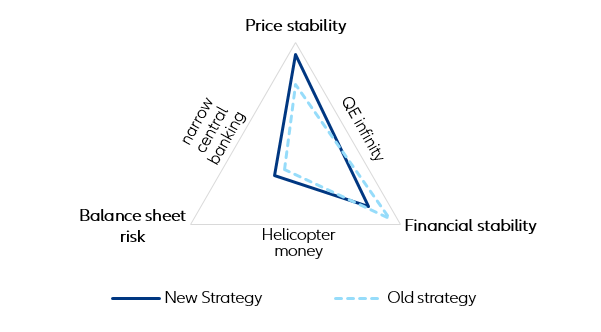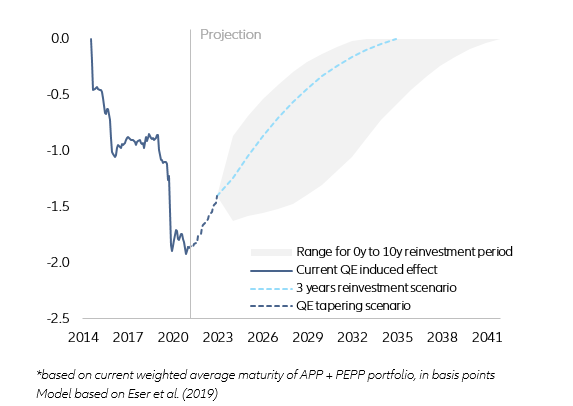ECB confirms dovish bias of its new strategy. In its closely-watched pre-holiday meeting, coming close on the heels of its strategy review, the ECB offered its first indications on how the new inflation target - raised from “close to but below 2%” to a symmetric medium-term target of 2% - will be implemented. Facing a trilemma between price stability (inflation target), financial stability (preventing fragmentation) and minimizing the balance sheet risk (avoiding fiscal/financial dominance), the ECB had moved towards price stability but remains strategically orientated in the “QE infinity” section (Figure 1).
Figure 1 – The ECB trilemma and strategic reorientation
We consider that the implementation of the new strategy offers more potential for dovish rather than hawkish policy. The changes to the forward guidance made today already go in this direction (Table 1), with the dovish shift on inflation and key rates from the strategy review confirmed. Hikes can now only occur if inflation reaches 2% "well ahead of the end of its projection horizon” (currently 2023) while “transitory” periods of “moderate” overshoot are allowed. The communication on Quantitative Easing (QE) remains largely unchanged. The decision on the tapering of the Pandemic Emergency Purchase Program (PEPP) has been pushed to Q4, probably together with the release of the new forecasts in September. The outlook for the usual open-end Asset Purchase Program (APP) remains also largely unchanged.
Table 1 – Changes in ECB forward guidance after strategy review
New wording, old problems. Rates markets have so far not embraced the ECB's new inflation target. Long-term inflation swaps and forward swaps remain well below the new target (10y swap at 1.5% , 5y5y forward swap at 1.6%). Money markets have taken a more dovish position than a month ago, pricing no significant rate hike before 2024. With today's meeting, the lift-off could be priced even further back. Regarding bond purchases, we believe the new strategic framework has limited the scope for an early tapering. With its inflation forecast currently at 1.4% in 2023, the ECB - at least under a strict interpretation of its new target - can hardly scale back the pace of its bond purchases. However, some hawkish members of the governing council had already pleaded for tapering the purchases in June, given the quick economic recovery. In addition, the PEPP, which accounts for 80% of the current bond purchases, is going to expire in March 2022. Today's meeting did not provide further information on this. Uncertainty around the spread of the Delta variant may have bought the ECB some time. But in the coming months, it will have to adress the conflict between its strategic inflation target, operational constraints (PEPP deadline, volume and issuer limits, market neutrality) and hawkish concerns.
A “double twist” for asset purchases? Today’s meeting confirmed our view that net asset purchases will continue until 2023. Therefore, parts of the PEPP purchases will likely be reallocated to the usual open-end APP. This twist should allow monthly net purchases of EUR60bn and total net purchases of at least EUR660bn in 2022 (Figure 3). This would be well below the volume of the two previous years, but still above the pre-crisis level.
Figure 3 - Overcoming the post-Covid-19 stumbling blocks
We also expect the current issuer limits to be handled more flexibly, especially for core government bonds and supranationals (Next Generation EU bonds). This could also give a twist to the definition of market neutrality, especially with regard to maturity. Hence, by extending the maturity of asset purchases, the ECB could exert noticeable influence on the long end of the curve even with fewer purchases (duration extracion). This could also defuse the problem between ongoing bond purchases and a possible debt consolidation if some form of fiscal rules are to be reintroduced at the European or national level (i.e. Germany). A more flexible interpretation of market neutrality would not actually be a big thing but rather officialize what the ECB is already doing. For instance, the country allocation within the Public Sector Purchase Program (PSPP) deviates strongly from market neutrality as the purchase key (based on ECB capital) is very different from the market shares within the Euro government bond market.
You don’t need QE infinity for longstanding QE effects. We expect that the discontinuation of net asset purchases in 2023 will be followed by a three-year phase of full reinvestment. In this scenario, the dampening effect of the central bank bond portfolio would still be 140bps for the 10y benchmark yield (vs 185bps today). As the portfolio matures, the effect would fade, but would still correspond to about 25bps in 10 years and would be completely gone in 2034 only. If, on the other hand, the reinvestment period were to last 10 years, the dampening impact of the current bond purchases would still correspond to 100bp in 10 years and would still be detectable in 2040. So you don't need QE infinity to achieve very long effects on the yield curve (Figure 4).
Figure 4 - Impact of QE on Euro 10y term premium with different reinvestment scenarios (in pp)*
Little upside for long-term yields. In this environment, we see little upside potential for long-term yields. We expect the 10y Bund to remain close to its current value - which corresponds to our fair value estimate - until year-end (Figure 5). The monetary stance also remains structurally supportive for Euro sovereign spreads. The anchor value of 100bps for the 10y spread betweeen Italy and Germany should hold until year-end.
Figure 5 – Little upside for 10y Bund until year-end







